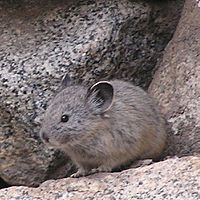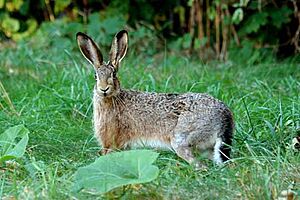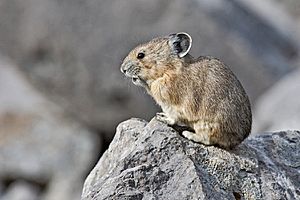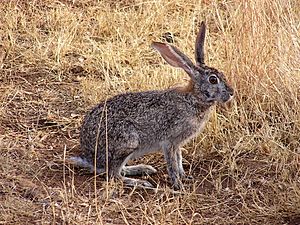Lagomorphs facts for kids
Quick facts for kids LagomorphsTemporal range: Earliest Eocene - Recent
|
|
|---|---|
 |
|
| Pika, Ochotona princeps, in Sequoia National Park | |
| Scientific classification | |
| Kingdom: | |
| Phylum: | |
| Class: | |
| Infraclass: | |
| Superorder: | |
| Order: |
Lagomorpha
Brandt, 1855
|
| Families | |
|
Leporidae |
|

Lagomorphs are a group of mammals that includes pikas, rabbits, and hares. Even though they might look like rodents, they are actually different. One big difference is that lagomorphs have four front teeth (called incisors) in their upper jaw, while rodents only have two. Also, lagomorphs mostly eat plants, unlike many rodents that eat both plants and meat.
For a long time, scientists thought lagomorphs were rodents, but they are now in their own special group. This group is split into two main families: Leporidae (hares and rabbits) and Ochotonidae (pikas).
Contents
What Makes Lagomorphs Special?
Lagomorphs share many traits with other mammals. They all have hair, four legs (which means they are tetrapods), and mammary glands to feed their young. They are also warm-blooded, meaning their bodies keep a steady temperature.
Lagomorphs vs. Rodents
Lagomorphs are more closely related to rodents than to other mammals. However, there are some important differences. As mentioned, lagomorphs have four incisors in their upper jaw, while rodents only have two.
Also, lagomorphs are almost always herbivores, meaning they only eat plants. Many rodents, however, eat both plants and meat. Like rodents, lagomorphs have front teeth that grow all the time. This means they need to chew on tough, plant-based foods constantly to keep their teeth from getting too long.
Differences Among Lagomorph Families
Rabbits and hares move by jumping. They push off with their strong back legs and use their front legs to land softly. Pikas are built a bit differently from rabbits and hares. They don't have the same highly arched skull or strong back legs. Pikas also have a shorter nose area and lack certain bone openings that rabbits and hares have above their eyes.
Pikas: Small Mountain Dwellers

Pikas are small mammals found in the mountains of western North America and Central Asia. They are usually about 15 cm (6 inches) long. They have grayish-brown fur, small round ears, and almost no tail. All four of their legs are nearly the same length.
Some pikas live in rocky areas, making homes in cracks between rocks. Others dig burrows in grassy uplands. Rock-dwelling pikas tend to live longer and are solitary. They have one or two small litters of young each year. Burrowing pikas, however, live shorter lives and are more social. They have many large litters throughout the year.
Pikas are active during the day, especially in the early morning and late afternoon when it's hot. They eat all kinds of plants. Since they don't hibernate in winter, they collect and dry plants to make "haypiles." They store these haypiles in their homes to eat when food is scarce.
Hares: Fast Runners

Hares are medium-sized mammals found on all continents except South America, Australia, and Antarctica. North American jackrabbits are actually a type of hare. Hares can be from 40 to 70 cm (16 to 28 inches) long. They have long, powerful back legs and ears that can be up to 20 cm (8 inches) long.
Most hares are grayish-brown, but some species turn white in winter. They are solitary animals. Young hares are born in a "form," which is a shallow dip in the ground hidden by plants. Baby hares are born with fur and can move around right away. Hares eat plants, including the bark of trees. They are often hunted by large meat-eating mammals and birds.
Rabbits: Burrow Builders
Rabbits are generally smaller than hares. They include species like the rock hares and the hispid hare. Rabbits live in Europe, parts of Africa, Central and Southern Asia, North America, and much of South America. They can be found in grasslands and dry areas.
Rabbits range from 20 to 50 cm (8 to 20 inches) long. They have long, strong back legs, shorter front legs, and a tiny tail. Their fur is usually brown, buff, or gray. There is one black species and two striped ones. Pet rabbits come in many more colors.
Most rabbits live and breed in burrows underground. Some burrowing species live in colonies, while others are solitary or feed in small groups. Rabbits are a very important part of the food chain. They eat many different plants, grasses, and herbs. In turn, they are a main food source for many meat-eating animals.
Where Lagomorphs Live Around the World
Lagomorphs are found almost everywhere on Earth, except for Antarctica. However, they are not common in most of southern South America, the West Indies, Indonesia, Madagascar, or many islands. Even though they are not native to Australia, humans brought them there. They have successfully spread across much of Australia, sometimes causing problems for local animals.
How Lagomorphs Stay Healthy
Digestion: Getting Nutrients from Plants
Like other plant-eaters, lagomorphs eat a lot of plant material. Plant cell walls are made of cellulose, which most mammals can't digest easily. But lagomorphs have a special way to get the most nutrition from their food.
First, they bite and shred plants with their front teeth. Then, they grind the material with their back teeth. Digestion starts in the stomach and small intestine, where nutrients are absorbed. After this, some food goes into a special pouch called the cecum. Here, bacteria and other tiny living things break down the cellulose into sugar. This process is called hindgut fermentation.
Other waste passes through the colon and is excreted as small, dry pellets. About four to eight hours after eating, the contents of the cecum are passed out as soft, moist pellets called cecotropes. Lagomorphs immediately eat these soft pellets. This allows them to get all the remaining nutrients from their food.
Reproduction and Early Life
Many lagomorphs have several litters of young each year. They produce many babies, especially species that breed in safe, underground places like burrows. Baby rabbits, called kittens, are born naked and helpless after a short time in the mother's womb. The mother can get pregnant again very soon after giving birth.
Mothers can leave their young safely in the burrow to find food. They return to feed them with their very rich milk. Some mothers only visit their litter once a day. The young grow quickly and are usually ready to stop drinking milk within a month.
Hares live above ground. Their babies, called leverets, are born in "forms" hidden among tall grass or bushes. Hares have a clever way to keep predators from finding their babies by following the adults' scent. They approach and leave the nest by making huge jumps, sometimes changing direction sharply. Baby hares are born with short fur and can move around soon after birth. They are born after a longer time in the womb, and there are usually fewer of them in a litter.
Images for kids
-
Fossil occurrences of leporids and ochotonids and global environmental change (climate change, C3/C4 plants distribution).
-
Skeleton of Alaskan hare (Museum of Osteology)
See also
 In Spanish: Lagomorfos para niños
In Spanish: Lagomorfos para niños





